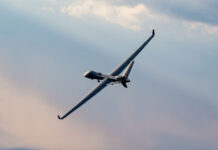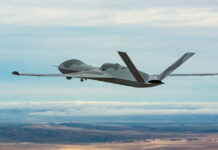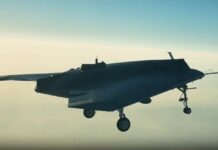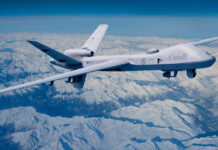General Atomics Aeronautical Systems Inc (GA-ASI) has “advanced its ability to operationalise the unmanned combat air vehicle (UCAV) ecosystem by combining advanced autonomy and government-provided human-machine interface (HMI) hardware”, the company announced on 9 August 2023.
During multiple flights a GA-ASI-owned Avenger unmanned aerial vehicle (UAV) was paired with ‘digital twin’ aircraft to autonomously conduct live, virtual, and constructive (LVC) multi-objective collaborative combat missions.
The flights, which took place on 13 July 2023 out of GA-ASI’s Desert Horizon Flight Operations Facility in El Mirage, California, “demonstrated the company’s commitment to maturing its UCAV ecosystem for autonomous collaborative platforms”, the company said. The ecosystem’s goal is to rapidly integrate best-of-breed capabilities in areas such as artificial intelligence (AI), mission-relevant interfaces, and other capabilities from third-party providers at the speed of relevance for 21st century conflicts.
The flights demonstrated manned-unmanned teaming (MUM-T) using the US Air Force’s Project FoX system, which included a touchscreen tablet for fighter cockpits. The tablet provided control and monitoring of advanced autonomy while it conducted a multi-objective combat mission consisting of LVC entities. Mission autonomy capabilities focused on optimised search and signature management.
“Search optimisation autonomy behaviours were provided by Scientific Systems Company, Inc (SSCI),” GA-ASI noted. “These skills were integrated into and orchestrated by government-furnished equipment (GFE) autonomy core architecture enhanced by GA-ASI. The flexibility of the GFE autonomy core software stack enabled rapid, seamless integration of one of SSCI’s multi-UAV behaviours. Autonomous trajectories were calculated by SSCI algorithms and subsequently communicated to GA-ASI’s autonomy core for translation to vehicle routes. SSCI provided an array of behaviours using its Collaborative Mission Autonomy suite where the software adapts to mission contingencies such as system failures, connectivity dropout, and combat losses to ensure successful tactical execution.”

“The concepts demonstrated by these flights set the standard for operationally relevant mission systems capabilities on UCAV platforms,” GA-ASI Senior Director of Advanced Programs Michael Atwood was quoted as stating in a company press release. “Our integration of the emerging FoX system accelerates speed to ramp for emerging collaborative air-to-air capabilities. The combination of airborne high-performance computing, sensor fusion, human-machine teaming, and AI pilots making decisions at the speed of relevance shows how quickly GA-ASI’s capabilities are maturing as we move to operationalise autonomy for UCAVs.”
The signature management displayed by the Avenger, based on deep reinforcement learning (RL), was developed by GA-ASI. Skill development leveraged GA-ASI’s novel RL architecture that was designed using agile software methodology and industry-standard tools such as Docker and Kubernetes. Commanded using the FoX tablet, the RL agent navigated the Avenger to an operator-identified target while minimising its radar cross-section. This MUM-T, facilitated via open mission system (OMS) messages and alignment to the newest government architectures, demonstrated real-time operator tasking and supervision of an autonomous platform as it conducted its mission.
GA-ASI says it is committed to maturing an autonomy infrastructure to enable rapid integration and validation of third-party tactical software applications from an app store while maintaining safety of flight. The latest flights were part of an ongoing series of autonomous flights performed by GA-ASI using internal research and development funding to prove out important AI/machine learning concepts for unmanned aerial systems.
Peter Felstead













